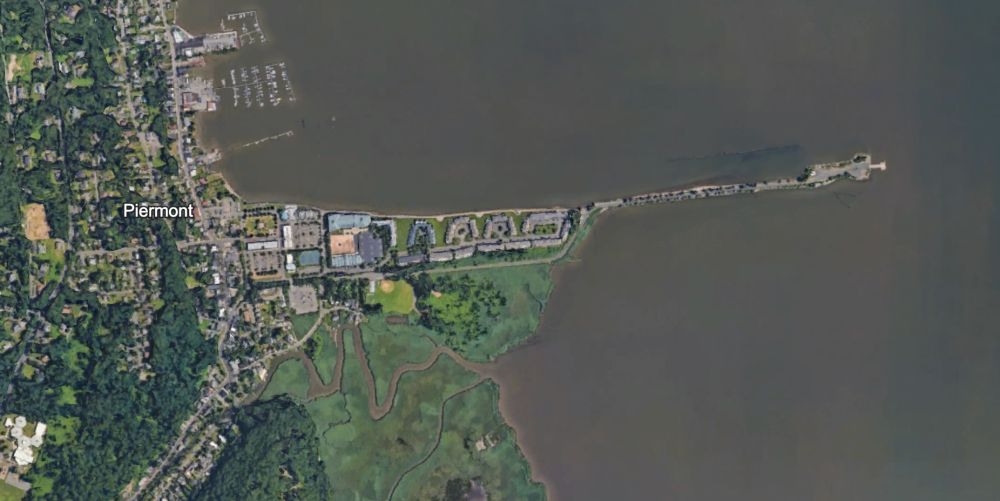Design is fundamentally a service business. Architects, graphic designers, illustrators, and the vanguard of digital designers all practice their craft with their clients’ goals top of mind.
But what if that client is a truculent sparrow, an iridescent starling, or a flaming red cardinal?
Thirty miles north of Midtown Manhattan lies the charming village of Piermont, New York (pop. 2,500). It’s one of many small towns along the mighty Hudson River. However, unlike any of its neighboring communities, it has one distinctive feature: a mile-long pier jutting out into the river.
via Google Earth
Originally built as a railroad link for a steamship terminal, it became the deployment point for over half a million soldiers boarding Navy vessels during World War II. Constructed out of earth and rock, the pier supports a two-lane access road and looks needle-thin when seen from above. It’s a popular recreational destination for Piermont and nearby communities who exercise, fish, cycle, and stroll out into the Hudson.
Bordering this pier is a teeming marsh, home to a fascinating assortment of birds. Common starlings, sparrows, cardinals, and blue jays share this location with flocks of gulls, ducks, mallards, Canadian geese, egrets, and cormorants. Birds of prey like ospreys, hawks, and an occasional bald eagle, attract “birders” and photographers.
Another lovely feature is dozens of charming “DIY” birdhouses mounted on trees along the pier.
I’ve lived in Piermont for nearly fifteen years and frequently walk the pier early in the morning for the sheer joy of standing a mile out into the Hudson. To the east is the town of Irvington, home of Washington Irving, writer, historian, and author of Rip Van Winkle. To the north is the imposing three-mile span of the Mario Cuomo Bridge (formerly the Tappan Zee Bridge). Looking south on a clear day, you can see a bit of the Manhattan skyline.
I don’t know any of the “designers” of these birdhouses. In fact, their creators remain a mystery. When I asked some of my neighbors, they were equally puzzled about the origin. Local artisans? Art students? Family projects? Whoever constructed the birdhouses did so with the abundant heart and soul common to all forms of folk art.
Here are three of my favorites:
The McMansion
At minus one square foot, this design offers a sumptuous, two-story, stone-clad residence with a stunning view of the river to the north from its five commanding turrets. I’m impressed with the care that went into the stonework and the touch of ivy on the façade. However, as with elaborate designs such as this, this luxurious mansion is showing its wear from the fierce weather conditions on the pier. I imagine it needs constant maintenance.
Cool and Modern
This design is a “prefab,” but charming all the same. Unconventionally, the front door is located on the left façade. The bright yellow siding, resplendent flower garden, and clean lines give it strong “curb” appeal. A sturdy metal bracket supports its structural integrity, discreetly etched with the manufacturer’s logo.
Just the Basics
Paint a multicolored wooden cube.
Rotate it 45 degrees.
Add a simple roof.
Drill a hole for the front door.
Attach a welcoming perch.
Nail it to a tree.
DONE!
This prime example of “affordable housing” is a simple, welcome, and noble complement to its upscale neighbors.
Do these designs meet the “functional brief”? I see little evidence of birds darting in and out of the residences during my morning walk. But maybe our fine-feathered friends are gone by dawn, off on a busy day of hunting and pecking, only returning home at dusk to roost.
These birdhouse designs might not get the Audubon Society’s seal of approval, but as delightful examples of community spirit and personal creativity, they are all prizewinning.
Ken Carbone is an artist, designer, musician, author, and educator. From 1976 to 2020, he was the Principal Creative Director of the Carbone Smolan Agency.
All imagery and videos © Ken Carbone, except where noted.
The post Design Is for the Birds: A Flight of Fancy on the Hudson River appeared first on PRINT Magazine.

